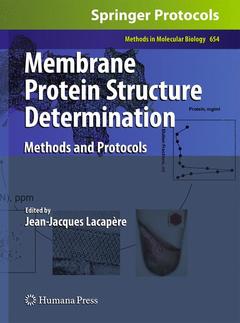Description
Membrane Protein Structure Determination, Softcover reprint of the original 1st ed. 2010
Methods and Protocols
Methods in Molecular Biology Series, Vol. 654
Coordinator: Lacapère Jean-Jacques
Language: English
Subjects for Membrane Protein Structure Determination:
Membrane Protein Structure Determination
Support: Print on demand
Support: Print on demand
Membrane protein structure determination: methods & protocols (Methods in molecular biology, Vol. 654)
459 p. · 17.8x25.4 cm · Hardback
459 p. · 17.8x25.4 cm · Hardback
Description
/li>Contents
/li>Comment
/li>
Membrane proteins, representing nearly 40% of all proteins, are key components of cells involved in many cellular processes, yet only a small number of their structures have been determined. Membrane Protein Structure Determination: Methods and Protocols presents many detailed techniques for membrane protein structure determination used today by bringing together contributions from top experts in the field. Divided into five convenient sections, the book covers various strategies to purify membrane proteins, approaches to get three dimensional crystals and solve the structure by x-ray diffraction, possibilities to gain structural information for a membrane protein using electron microscopy observations, recent advances in nuclear magnetic resonance (NMR), and molecular modelling strategies that can be used either to get membrane protein structures or to move from atomic structure to a dynamic understanding of a molecular functioning mechanism. Written in the highly successful Methods in Molecular Biology? series format, chapters include introductions to their respective topics, lists of the necessary materials and reagents, step-by-step, readily reproducible laboratory protocols, and tips on troubleshooting and avoiding known pitfalls. Comprehensive and easy to use, Membrane Protein Structure Determination: Methods and Protocols serves as an ideal reference for scientists seeking to further our knowledge of these vital and versatile proteins as well as our overall understanding of the complicated world of cell biology.
Membrane Protein Purification.- Characterization of Membrane Protein Preparations: Measurement of Detergent Content and Ligand Binding After Proteoliposomes Reconstitution.- Native Membrane Proteins vs. Yeast Recombinant: An Example: The Mitochondrial ADP/ATP Carrier.- Bacterial Overexpressed Membrane Proteins: An Example: The TSPO.- Insect Cell Versus Bacterial Overexpressed Membrane Proteins: An Example, the Human ABCG2 Transporter.- X-Ray Crystallography.- Crystallography of Membrane Proteins: From Crystallization to Structure.- Structural Approaches of the Mitochondrial Carrier Family.- What Can Be Learned About the Function of a Single Protein from Its Various X-Ray Structures: The Example of the Sarcoplasmic Calcium Pump.- Recent Progress in the Structure Determination of GPCRs, a Membrane Protein Family with High Potential as Pharmaceutical Targets.- Electron Microscopy.- Observation of Membrane Proteins In Situ: AQPcic, the Insect Aquaporin Example.- Two-Dimensional Crystallization of Integral Membrane Proteins for Electron Crystallography.- Structure Determination of Membrane Protein by Both Cryo-Electron Tomography and Single Particle Analysis.- Electron Microscope Tomography of Native Membranes.- From Electron Microscopy Maps to Atomic Structures Using Normal Mode-Based Fitting.- Nuclear Magnetic Resonance.- Determination of Membrane Protein Structures Using Solution and Solid-State NMR.- Membrane Protein Fragments Reveal Both Secondary and Tertiary Structure of Membrane Proteins.- What Can We Learn from a Small Regulatory Membrane Protein?.- Solution-State NMR Spectroscopy of Membrane Proteins in Detergent Micelles: Structure of the Klebsiella pneumoniae Outer Membrane Protein A, KpOmpA.- NMR Spectroscopy of Lipid Bilayers.- Molecular Modelling.- Critical Review of General Guidelines for Membrane Proteins Model Building and Analysis.- 3D Structural Models of Transmembrane Proteins.- Molecular Dynamics of Membrane Peptides and Proteins: Principles and Comparison to Experimental Data.- Membrane Protein Dynamics from Femtoseconds to Seconds.- The Family of G Protein-Coupled Receptors: An Example of Membrane Proteins.
Addresses significant hurdles to membrane protein purification Describes techniques that permit the capture of atomic scale pictures of membrane proteins Includes tips for avoiding protocol pitfalls Includes supplementary material: sn.pub/extras
© 2024 LAVOISIER S.A.S.




